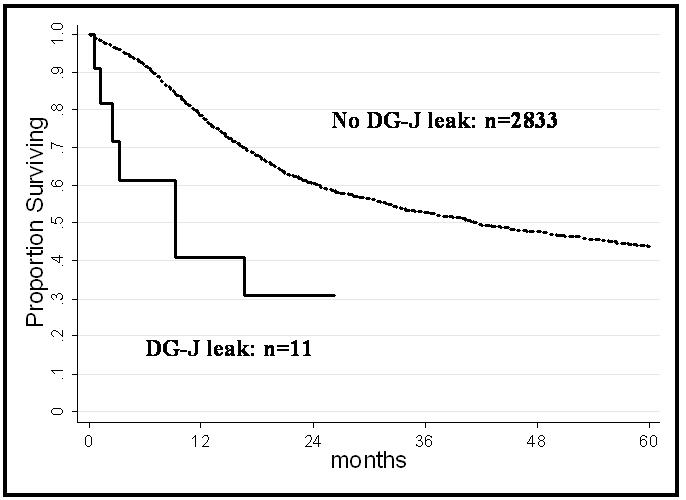Objective: Duodeno- or gastrojejunostomy (DG-J) leaks following pancreaticoduodenectomy (PD) have not been well characterized.
Methods: Perioperative data for 2844 patients who underwent a PD at our institution were reviewed. Patients were divided into two groups depending on whether or not a postoperative DG-J leak had occurred, and compared with respect to relevant perioperative variables.
Results: Eleven patients developed a postoperative DG-J leak (10 DJ leaks and 1 GJ leak). The leaks were detected an average of 10 days after surgery (range 6 to 28 days); the clinical presentation included abdominal pain, leukocytosis (the median WBC was 29,000 cells/mm3), fever, and enteric drainage through the midline incision. The two study groups were comparable with respect to demographic data, past medical history, and pathology (70% of specimens in both groups harbored a periampullary cancer). Increased blood loss (median 1500 ml vs. 700 ml, p=0.01), intraoperative blood transfusions (median 2 units PRBC vs. 0 units PRBC, p=0.001), and a higher proportion of total pancreatectomies (27% vs. 5%, p<0.001) were associated with the development of a DG-J leak. In patients with and without a postoperative DG-J leak respectively, the mortality rates were 9% and 2% (p=0.06), the reoperation rates were 91% and 4% (p<0.001), and the median postoperative lengths-of-stay were 43 and 10 days (p<0.001). Patients with a DG-J leak had a significantly worse long-term survival than patients without a DG-J leak (p=0.04).
Conclusion: DG-J leaks are typically associated with more extensive operations involving increased blood loss. Although unusual, this complication following PD has a profoundly negative impact on patient outcome reflected by increased length-of-stay, an increased reoperation rate, and worse long-term survival.
Survival after PD, based on whether or not a DG-J leak occurred
 500 Cummings Center
500 Cummings Center +1 978-927-8330
+1 978-927-8330
 +1 978-524-0461
+1 978-524-0461